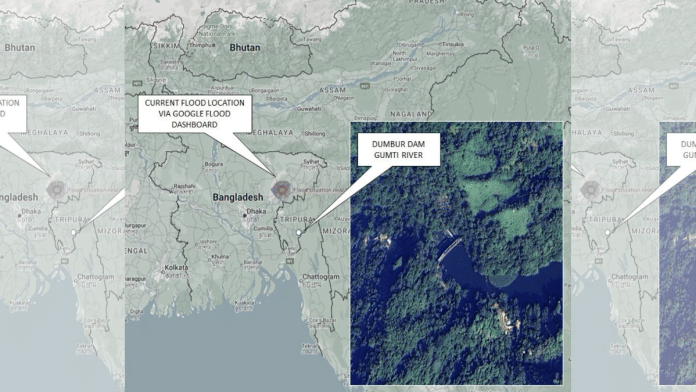New Delhi: A blame game over floods on Bangladesh’s eastern border has become the latest flashpoint between Delhi and the new interim government in Dhaka led by Nobel laureate Mohammed Yunus.
The Ministry of External Affairs (MEA) issued a statement Thursday saying Bangladeshi claims that floods were caused as a result of opening the Dumboor dam, upstream of the Gumti River in Tripura, were “factually not correct”. “The flood in Bangladesh is primarily due to waters from these large catchments downstream of the dam,” it read.
Earlier, students of Jagannath University (JnU) in Dhaka staged a protest blaming India for allegedly opening sluice gates of Dumboor dam without informing Bangladesh. Officials from the Bangladesh Water Development Board (BWDB) made the same claim while talking to local media.
Floods on the common rivers between India and Bangladesh are a shared problem that rears its head almost every year. In its statement, the MEA said the Indian side is regularly communicating with Bangladesh on data about the flooding despite a power outage that occurred at 6 pm Wednesday. “Still, we have tried to maintain communication through other means created for urgent transmission of data,” the MEA said.
In July, when now-ousted Bangladesh prime minister Sheikh Hasina was still in power, she had instructed authorities to prepare for more floods this year. Former planning minister Abdus Salam was quoted as saying in a report by The Daily Star, “Based on weather analyses, the premier anticipates possible flooding soon. We must be ready to take necessary actions if it occurs.”
Earlier this month, Yunus and his 16-member advisory council were sworn in after Hasina’s ouster. Prime Minister Narendra Modi also spoke to Yunus last week and discussed ways to take the bilateral relationship forward along “respective national priorities”.
Since coming to power, Bangladesh’s interim government has been critical of Hasina’s “closeness” to India and her decision to take refuge in Delhi.
De-facto foreign minister Mohammad Touhid Hossain told Reuters last week that Hasina’s stay “creates an embarrassing situation” for New Delhi. Yunus had also previously remarked that Hasina’s exit marked a “second liberation” for Bangladesh.
Claims by Bangladesh officials
In its statement, the MEA took note of “concerns being expressed in Bangladesh” as well as claims that India lifted the gates of a critical dam that led to the floods. However, it did not clarify whether the Yunus-led government had raised the issue officially at the bilateral level.
Meanwhile, officials in Bangladesh claimed India opened the Dumboor dam without giving advance notice to Dhaka.
“No, we were not notified by the Indian side about their decision to open the reservoir sluice gate,” Partha Pratim Barua, a sub-divisional engineer working with the Bangladesh Water Development Board (BWDB) told Dhaka Tribune.
“We (Bangladesh and India) have MoUs for exchanging rainfall data at 14 points in various border zones, but the Comilla-Tripura front isn’t covered under those MoUs. We still manage to gather rainfall data from across the border in one way or the other, but when it comes to one side’s decision to open a sluice gate, there’s no tradition of notifying the other side,” said Barua who works at BWDB’s flood forecasting and warning centre.
In its statement, the Indian side said the Dumboor dam was located quite far from the border between the two countries, approximately 120 km upstream of Bangladesh. “It is a low height (about 30m) dam that generates power that feeds into a grid and from which Bangladesh also draws 40 MW power from Tripura,” the MEA said.
Along the nearly 120km river course, India has three water-level observation sites at Amarpur, Sonamura and Sonamura 2.
“Heavy rainfall has been continuing since 21 August in the whole of Tripura and adjoining districts of Bangladesh. In the event of heavy inflow, automatic releases have been observed,” read the MEA statement.
Ratan Lal Nath, minister of power, agriculture and farmers’ welfare in Tripura, also sought to dispel the claims. “No gate has been opened for the Gumti Hydro Electric Project. The storage capacity of the reservoir is up to 94 metres. Once the water crosses this level, it will automatically exit through the gate. Again, when the water level of the reservoir falls below 94 metres, the gate will automatically close,” he wrote on X Wednesday.
গোমতি হাইড্রো ইলেকট্রিক প্রজেক্ট এর কোন গেইট খুলে দেওয়া হয়নি। রিজার্ভারের ধারণ ক্ষমতা ৯৪ মিটার পর্যন্ত। জল এই স্তর অতিক্রম করলেই অটোমেটিক্যালি গেট দিয়ে বেরিয়ে যাবে। আবার রিজার্ভারের জল স্তর ৯৪ মিটারের নিচে নেমে গেলে অটোমেটিক্যালি গেইট বন্ধ হয়ে যাবে। pic.twitter.com/qOVLtOoksR
— Ratan Lal Nath (@RatanLalNath1) August 21, 2024
The Gumti Hydroelectric Power Project is essentially a power plant in the basin of the Gumti river and located in South Tripura district.
Edited by Tikli Basu)
Also read: Hasina was no friend of Hindus, BNP wants friendly ties with India, says top party leader






